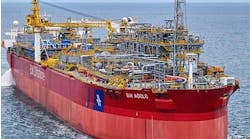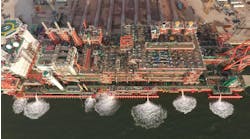Leonard LeBlanc
Houston
When will El Niño again impact US gas industry?
The welfare of the US gas industry now seems directly coupled to the presence or absence of El Niño (more properly El Niño-Southern Oscillation cycle), the periodic warm offshore currents that blow into South America from the west, in turn keeping the North American continent unduly warm over the winter months. The 1995-1996 winter season is the first normal winter in some years, free of all effects from El Niño, and gas prices have been higher than in recent years.
So, when will the next El Niño occur?
There is wide disagreement among scientists, but most guesses range from the year 2000 to 2004. This means normal winters for at least four years - maybe. The most recent El Niño began in 1988 and began to cycle down in 1992. However, short events occurred during the following two years, before disappearing entirely by 1995. There seems to be at least one El Niño per decade.
The present confusion over when the next event will occur is twofold:
- The pattern of reoccurrence is difficult to discover and duration is even more obscure.
- Global warming, whether natural or man-induced, may be altering event patterns.
Using oceanic and atmospheric coupled temperature models, scientists can predict a new event as much as one year in advance. In order to reach the one-year prediction confidence point, researchers have used historical data from the past several decades in order to reconstruct events leading to El Niño's of recent vintage, and most notably, the one in 1988.
However, one year is as far out as the confidence extends. There have been too many false alarms for prediction beyond that point. At this stage of research, global weather modelers don't yet know whether predictability is being limited by the inadequacy of the ocean-atmosphere models, by the lack of measurement accuracy, or simply the chaos of pre-event dynamics.
Liquefaction of seabed soils during earthquakes, hurricanes
As producers plan more oil and gas developments in earthquake zones around the globe (Sakhalin, Philippines, etc.) earthquake design of fixed platforms and floaters (peak surge and sway) will be taken into consideration. One element of earthquake design for fixed structure - liquefaction of sand and soils - may not, however.
Sand and silt lose their strength during liquefaction, because the materials' tendency to compact during severe shaking shifts stresses from grain-to-grain contacts to the pore space liquids. The resistance to shearing or deformation is reduced as pore water pressure increases. During maximum events, such as severe earthquakes seen on land, sands and silts turn to water. All support for surface or imbedded structures is removed.
Although fixed offshore structures are deeply piled into the seabed, extreme seismic events could liquefy soils along the top portion of the pile depth, allowing the structure to sink far enough as to be unusable. This has not occurred to an offshore producing structure yet, but increasing development in earthquake zones will make this a possibility. Generally, the presence of consolidated clays along the piling path, which can make pile driving difficult to begin with, reduces liquefaction response.
Hurricanes and typhoons can create the same seabed conditions. Wave tank tests and seabed evidence in the wake of such events show that high variations in water pressure and subsequently, seabed liquefaction, begin when the magnitude of surface waves occupies a certain percentage of the water column. Low air pressure at the surface may have something to do with it, also.
While wave and wind loads on fixed structures during hurricanes are the most dominant toppling force, the exact role of seabed liquefaction during these events is difficult to ascertain. There is reasonable suspicion that soil liquefaction plays a greater role in releasing the hold of anchors, embedded gravity structures, angled piles, as well as deep vertical piles during extreme wave events, maximizing the impact of loads at the surface. The fact that platforms rendered relatively transparent to high wave and wind loads have been easily toppled suggests that liquefaction plays a strong role.
There is another more disturbing phenomena, and this may be more applicable to earthquake prone areas of the world. Once sand has been moderately liquefied in the recent past, it then becomes more responsive to the forces that cause liquefaction for some time afterward.
Has finite element analysis shortcut been developed?
The most widely used equations in design and analysis of offshore structures involve finite element analysis (FEA). Any structural member or construction can be broken into thousands of separate pieces to calculate individual stresses and strains, and the functions integrated to estimate global stresses and strains. While the solutions are considered the best available under the circumstances, there are long-standing problems with the process:
- Unless the element or construction is well known or standard, FEA formulas must be set up. The more original design work, the more FEA must be done.
- Complex or critical elements require large amounts of computer time. Sometimes projects are time sensitive.
- In virtually all cases, there are multiple solutions. Sometimes, there is little indication of the most correct one.
Michael Lamorte of Applied Engineering Software (Durham, North Carolina, USA) believes he has a creditable alternative to FEA - closed-point solutions to a mesh-point field, or CLAMP as the author calls it. Details of the formulation are few thus far, but the basics involve laying out a mesh grid over the structure and setting up calculations for what happens at each point in the grid.
Mesh points are fewer than entire finite elements, and the calculation goes much faster. Thus far, Lamorte has come up with solutions 200-400 times faster than with FEA. How do the solutions compare. Since FEA is somewhat indefinite, it is hard to tell, but the CLAMP solutions appear realistic to many of the engineers who have tried Lamorte's method. While skeptics of the CLAMP method are still many, the results are convincing, nonetheless.
Tougher ceramics may be on the way
Materials developers who develop metal-ceramics for high temperature applications may now have a solution for toughening the exterior of such products for use in tough abrasive environments, such as downhole.
The solution involves tempering the ceramic during manufacturing. Alumina-ceramic tubes are packed with nickel aluminate powder, and then using heat and pressure to get the powder to stick to the inside of the tube walls. The tube is then baked to deoxidize the aluminate, reducing the volume of the aluminate and pulling the tube inward. Since the tube cannot shrink, it creates a strain that hardens the exterior of the tube.
Sulfur-based breakdown of oil
A bacterium discovered on the seafloor in an oxygen free environment can break down crude oil, a task previously considered improbable. The bacterium uses sulfur or sulfates as it's conversion medium instead of oxygen. The bacterium, also believed to sour reservoir oils, was discovered by a crew from Woods Hole Oceanographic Institute in 6,000-ft depths.
Copyright 1996 Offshore. All Rights Reserved.


